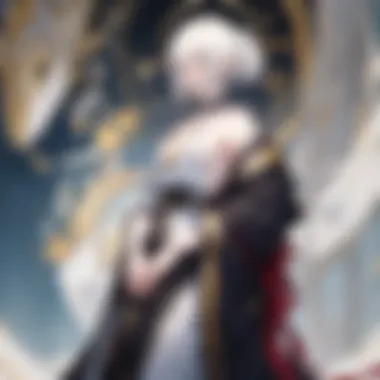Exploring Naki: A Deep Dive into Cultural Significance


Intro
The concept of Naki signifies a crucial aspect within the realms of anime and manga, weaving into the very fabric of character development and narrative structure. This exploration delves into Naki's usage, its emotional resonance, and how it shapes contemporary fandom while considering its historical roots in Japanese media.
By studying this cultural phenomenon, audiences can gain insights into the multi-layered meanings attributed to Naki. As we unfold this discussion, it becomes evident that Naki is not just a fleeting trend, but a persistent element reflecting deeper psychological and emotional dynamics.
As we proceed, we will begin with the foundational elements that make up this concept, establishing a basis for understanding Naki's impact on stories and the audiences that connect with them.
Series Overview
Synopsis and Premise
Naki is often intertwined with the emotional undertones present in anime and manga narratives. The premise typically revolves around themes of loss, yearning, and connection. Characters often find themselves navigating their internal struggles, contributing to the richer storytelling that has captivated fans. By reflecting on these emotional states, creators invite viewers to embark on a compelling journey that resonates with their own experiences.
“Naki encapsulates the very essence of human emotion, offering a gateway for audiences to process their feelings through the lens of fictional characters.”
Notable Characters
Noteworthy characters embodying the notion of Naki bring life to its interpretations. These figures often carry heavy emotional weights, battling personal demons or enduring losses. A few significant examples include:
- Shinji Ikari from Neon Genesis Evangelion: His struggle with personal identity and connection illustrates the essence of Naki.
- Mitsuha Miyamizu from Your Name: The longing for connection and the emotional depth journeys reflect Naki's profound influence.
- Anya Forger from Spy x Family: Through her innocent perspective, she portrays longing and hope, engaging audiences deeply with Naki.
Themes and Motifs
Major Themes Explored
Naki also serves as a vessel for numerous overarching themes in anime and manga. Themes of loss, grief, and the pursuit of connection resonate widely among audiences. Each narrative using Naki explores:
- Emotional Resilience: Characters learn to navigate their feelings and find strength in vulnerability.
- The Effects of Isolation: Naki often highlights the importance of community and relationships.
Symbolism in Storytelling
Symbolism plays a pivotal role in how Naki is conveyed. Objects, settings, and character actions may symbolize the complexity of human emotions. Creators utilize various artistic elements:
- Weather: Rain often parallels sorrow or introspection.
- Colors: Dull colors might signify melancholia, while vibrancy can indicate hope.
Artistic Style and Animation
Visual Aesthetics and Design
The visual representation of Naki adds depth to its understanding. Art styles vary significantly, with some employing soft color palettes to evoke emotional responses. The distinct designs aim to mirror the characters’ inner turmoil, enhancing the narrative.
Animation Techniques and Trends
Animation techniques further enrich how Naki manifests on-screen. Recent advancements in animation, such as fluid motion or impactful framing, have intensified emotional portrayals. This lends a more immersive experience for the audience, as they find themselves drawn into the narrative.
In summary, Naki is a profound cultural phenomenon that enriches the worlds of anime and manga. Through detailed explorations of character journeys, emotional depth, and artistic expressions, this concept remains essential in understanding modern-day storytelling.
Understanding Naki
Understanding Naki is crucial for appreciating its multifaceted role within anime and manga. Naki transcends simple definition; it embodies a range of emotional experiences and cultural expressions. By unpacking this concept, one can better understand the character arcs, plot developments, and thematic depth that define many narratives in this medium. This section will explore the nuanced definition of Naki and the cultural context in which it exists.
Definition of Naki


Naki refers to a complex emotional state often depicted in anime and manga, characterized by deep sadness or sorrow. It can manifest in various forms, including crying, lamentation, or profound reflection. This term captures not only the act of expressing grief but also the underlying emotional currents that drive characters and narratives forward. Naki can serve as a catalyst for character development, shaping a character’s journey and affecting their interactions with others. This emotional layer enhances the storytelling, allowing for a richer viewer or reader experience. The use of Naki is not merely for dramatic effect; it symbolizes the human experience and resonates with audiences in a compelling way.
Cultural Context
The cultural context of Naki is deeply rooted in Japanese traditions and artistic expression. In Japanese culture, emotions are often conveyed subtly, leaving space for interpretation. Naki embodies this subtlety, reflecting a cultural appreciation for emotional depth and complexity. Many stories highlight the beauty in sorrow, suggesting that such feelings are essential to understanding life’s intricacies. Furthermore, Naki aligns with the broader themes seen in various Japanese artistic forms, including literature and theatre. In anime and manga, the integration of Naki into characters and plots reflects societal values, personal struggles, and communal experiences, making it a significant element of cultural storytelling.
"Naki is not just a trope; it is a window into the emotional landscape of the characters and, by extension, the audience."
Thus, understanding Naki offers valuable insights into the emotional fabric that weaves together narratives and characters in anime and manga.
Naki in Character Development
Naki plays a pivotal role in character development within anime and manga. Understanding its implications enhances the narrative quality and character arcs. Characters in these stories often exhibit various forms of Naki, providing depth to their emotional experiences and motivations. This section explores how Naki influences the emotional complexity of characters and serves as a catalyst for conflict.
Emotional Depth of Characters
Characters adorned with Naki often resonate with audiences on a profound level. The emotional landscape painted by their experiences signifies more than mere sentiment; it reflects their growth and struggles. Naki allows for an exploration of internal conflicts, shaping a character's identity. Viewers identify with characters who embody vulnerability, fatigue, or sorrow. For example, the protagonist in "Your Lie in April" demonstrates Naki through emotional turmoil, revealing the depth of loss and passion.
Through Naki, the audience witnesses the gradual evolution of a character's psyche. This connection enhances the viewing or reading experience, transforming it from passive observation to active engagement. Characters become more relatable as they experience shared human emotions. Therefore, Naki not only enriches their emotional depth but also facilitates personal reflection among viewers.
"Understanding Naki is crucial for grasping the intricate relationships between characters and their journeys. It is through this lens that we view their humanity."
Naki as a Tool for Conflict
Naki often serves as a powerful tool for establishing conflict within narratives. This conflict can be internal, as in the case of characters grappling with their feelings, or external, influencing interactions with others. By embodying Naki, characters can catalyze pivotal moments that drive plots forward.
For instance, in "Attack on Titan," Naki manifests through the internal struggles of Eren Yeager. His very essence is a response to loss and betrayal, providing a rich soil for conflict with his allies and adversaries alike. This embodiment of Naki not only enhances the drama but also deepens the stakes of the narrative. The presence of Naki naturally leads to clashes that reveal hidden motives and amplify tension.
Additionally, employing Naki within character conflicts encourages the audience to reflect on larger themes such as sacrifice, loyalty, and revenge. The dramatic weight added through these conflicts leaves a lasting impression, provoking thought and discussion within fan communities.
In summary, Naki significantly affects character development in anime and manga. By examining the emotional depth and the conflicts arising from Naki, readers and viewers can grasp the complexities that define their favorite characters.
Narrative Techniques Involving Naki
Naki plays a pivotal role in storytelling within anime and manga. Its influence can be seen across various narrative techniques, serving both aesthetic and functional purposes. Understanding these techniques enhances the appreciation of how Naki shapes character interactions and plot developments. This section will explore significant aspects of narrative techniques involving Naki, emphasizing its multifaceted benefits and the careful considerations that creators employ when incorporating this theme.
Naki Across Different Genres
Naki is not confined to a single genre; instead, it permeates various thematic landscapes, effectively adapting to the nuances of each genre. In shonen anime, for example, Naki can fuel action-packed sequences, adding emotional stakes to confrontations among characters. Thus, it enriches the conflict and heightens the viewer's engagement.
In shoujo works, Naki often expresses the complexity of relationships and personal growth. It shapes character arcs, providing depth to romantic interactions or internal struggles. The emotional depth radiated through Naki can evoke a resonant response, reinforcing the theme of vulnerability.
Additionally, Naki exists in slice-of-life stories, presenting subtle moments of emotional truth. Within this genre, it serves as a tool to explore everyday experiences, evoking a sense of relatability. These various uses across genres reveal the adaptability of Naki, demonstrating how it enhances various forms of storytelling.
Storytelling Strategies
Employing Naki requires strategic thought. Creators often consider pacing, tone, and character development when involving Naki. A well-timed moment of Naki can shift the audience's perspective, prompting them to reconsider a character's motivations or actions. Integrating Naki during climactic events makes those moments more impactful, forging strong connections with the audience.
Furthermore, the layering of Naki with other narrative elements, such as foreshadowing or symbolism, provides additional layers of meaning. Naki can encapsulate existential themes, such as loneliness or existential dread, inviting deeper reflection from the audience.
The Emotional Impact of Naki
The emotional impact of Naki extends far beyond simple aesthetics in anime and manga. It weaves itself into narratives, creating connections that resonate on profound levels. Understanding how Naki influences emotions is crucial for both creators and audiences. This insight helps in appreciating the richness of storytelling that Naki brings.
Viewer and Reader Reactions


Viewer and reader reactions to Naki can often be intense. This emotional response functions as a gauge for the deeper themes present in a story. Naki can evoke feelings of joy, sadness, nostalgia, or even a sense of closure. These are significant elements to consider when analyzing why certain narratives resonate deeply.
In many cases, viewers find themselves relating to the emotional states portrayed in characters experiencing Naki. This personal connection fosters a sense of belonging within the audience, creating communities around shared experiences. Some may find joy in watching a character overcome struggles, while others might find solace in relatable pain or sadness.
"The power of Naki lies in its capacity to transform a simple animation into human experiences that echo real life."
The instant reactions in social media platforms like Reddit or Facebook often demonstrate how powerful these emotional hooks can be. Hashtags and discussions grow rapidly, illustrating how an episode or chapter resonates, allowing fans to express their feelings collectively. This interactivity has created a culture of sharing thoughts that make the Naki phenomenon even more influential.
Psychological Perspectives
The psychological implications of Naki are significant. From a psychological standpoint, Naki serves as a reflection of human emotions, often revealing universal truths about the human condition. This aspect can lead to various interpretations based on individual viewer circumstances. As viewers immerse themselves, they often undergo a cathartic experience.
Emotional responses to Naki can also trigger introspection. Such reflection prompts viewers to examine their own lives and emotions, affirming the power of narrative art forms. Research in psychology shows that media that evokes emotional responses can promote understanding and empathy. This is particularly evident in how fans handle complex themes depicted through Naki.
Historical Roots of Naki
The historical roots of Naki are crucial to understanding its significance within the realms of anime and manga. The term encapsulates a variety of emotional expressions and character-building elements, which resonate deeply with audiences. Understanding its origins and the transformations it has undergone provides valuable insights into how Naki reflects broader cultural shifts and individual experiences in storytelling.
Origins in Japanese Culture
Naki has its origins deeply embedded in Japanese culture, where emotional expression is an integral part of artistic forms. Traditionally, Japanese art often emphasizes the ephemeral nature of life, a concept closely related to Naki. In literature, this is visible in the works of writers like Matsuo Basho, who employed themes of loss and beauty. Similarly, in folklore, numerous tales capture the essence of longing and sorrow that characterize Naki.
This connection to Japanese heritage establishes a framework within which Naki not only thrives but also evolves. It serves as a mirror reflecting societal values and personal struggles, making it relatable to many. The aesthetic principle of mono no aware—the awareness of the impermanence of things—also underlines Naki, reinforcing its foundation in a culture that cherishes transient beauty and emotional depth.
Evolution Over Time
The evolution of Naki over time illustrates how cultural elements can adapt while retaining their core meaning. Initially rooted in literature and traditional theater forms, Naki expanded with the advent of modern media. Anime and manga became platforms that showcased Naki in new dimensions, enhancing its appeal to younger generations.
In the 20th century, the portrayal of Naki began to solidify in popular narratives. Shows like "Naruto" and "Your Name" interwove themes of longing, loss, and connection through their characters' journeys. As anime gained global popularity, the concept of Naki also traveled beyond Japanese borders, influencing works and fandoms worldwide.
In contemporary settings, Naki continues to evolve through various genres, offering diverse representations that resonate with global audiences. The impact of digital media cannot be overlooked, as fan creations and discussions often explore and redefine what Naki means in today's context.
"As Naki evolves, it remains a vital means of emotional expression, linking fans with their cultural heritage while exploring new narratives."
Overall, the historical roots of Naki showcase its profound influence on storytelling and character development within anime and manga. Understanding its origins and evolution not only enriches appreciation for these forms of media but also highlights Naki's relevance in contemporary discussions of love, loss, and identity.
Naki in Contemporary Media
Understanding Naki within the framework of contemporary media is crucial. It reveals how this cultural phenomenon transcends traditional boundaries of storytelling and character representation in anime and manga. Naki serves as a conduit for exploring deeper emotional landscapes, providing creators with a tool for enhancing narrative depth and complexity.
Trends in Anime and Manga
In recent years, the portrayal of Naki has evolved alongside shifts in audience expectations. Many notable trends have emerged in the anime and manga industries:
- Character Complexity: Modern narratives often feature characters who experience profound emotional turmoil, using Naki to articulate their struggles. Series like "Attack on Titan" and "Your Lie in April" showcase this trend, emphasizing vulnerability and resilience.
- Diversity of Genres: Naki is not confined to a single genre. From slice-of-life to horror, its application varies, allowing for distinct expressions of emotion. Works such as "Your Name" juxtapose Naki with elements of fantasy, showcasing the breadth of possible narratives.
- Integration with Technology: Digital platforms have facilitated the exploration of Naki by providing interactive storytelling experiences. Streaming services allow viewers to engage with episodes, leading to a collective experience that enhances the emotional connection to Naki elements.
Global Reception
The global reception of Naki reflects its universality and relevance across cultures. Audiences around the world have engaged with Naki themes, leading to varied interpretations:
- Cultural Adaptations: Many international adaptations of anime and manga incorporate local cultural aspects while retaining the essence of Naki. This merging creates a rich tapestry of cultural understanding and appreciation.
- Fandom Communities: Online platforms like Reddit and Facebook serve as gathering spaces for fans to discuss and analyze Naki. This communal discourse allows for diverse viewpoints, enriching the understanding of Naki and its implications.
- Critical Acclaim: Numerous works exploring Naki have received accolades across major award platforms. This recognition underscores the importance of Naki in modern media and its role in cultural conversations.
"Naki has become more than just a narrative device; it represents a bridge between cultures, fostering dialogue and empathy among diverse audiences."


Naki and Fandom
Naki has not only shaped storytelling in anime and manga, but it also plays a significant role in the fandom surrounding these mediums. Understanding the relationship between Naki and its enthusiasts provides insight into how cultural elements evolve and are interpreted by diverse audiences. This section will explore community interpretations and the role of online platforms in shaping these fandoms.
Community Interpretations
Within the realm of the Naki concept, community interpretations vary widely. This diversity enhances the richness of fan interactions and discussions. Fans often engage in deep analysis, providing their perspectives on the emotional depth that Naki brings to various narratives.
The significance of fan interpretations is substantial. They allow for varied readings of characters and stories, fostering a sense of inclusion and participation. For instance, how Naki manifests in different characters may lead to interpretations centered on vulnerability, human connection, and even existential dilemmas. These interpretations can serve as a mirror reflecting the complexities of real-life emotions and experiences.
Another key aspect is the way fans may express their understanding of Naki through creative means. This includes fan art, fan fiction, and even cosplay. Engaging with the topic through creativity allows fans to deepen their connection to the source material while exploring the concept of Naki in unique ways. This vibrant community discourse fosters a sense of belonging among fans.
"The community engages not just with characters, but with their emotional journeys, enriched by the nuances of Naki."
Role of Online Platforms
Online platforms have significantly transformed the way fans interact with Naki and its associated narratives. Websites like Reddit and Facebook provide spaces where fans can come together to discuss their interpretations, insights, and reactions. Such platforms have allowed for the rapid spread of ideas and perspectives that might not have gained traction otherwise.
For example, Reddit's numerous subreddits focusing on specific anime or manga create an environment conducive to in-depth discussions. Fans can dive into the layers of Naki as they relate to different characters and plotlines, sharing thoughts and analysis with others around the globe.
Moreover, social media platforms enable fans to showcase their creative outputs. Artists and writers can share their work and receive feedback, which fosters a collaborative atmosphere that enhances fandom engagement. The immediacy of online interactions allows trends related to Naki to emerge quickly, keeping the fandom vibrant and evolving.
In summary, the connection between Naki and fandom exemplifies a dynamic interaction where interpretations and online engagement contribute to a deeper understanding of this cultural phenomenon. As fans continue to explore and express their views on Naki, the significance of this concept in the broader narrative landscape only grows.
Philosophical Implications of Naki
The exploration of Naki extends beyond entertainment and enters the realm of philosophy. This section highlights how Naki reflects deeper existential questions and cultural narratives. By examining these implications, we could see Naki as a lens through which creators and audiences understand themselves and their society.
Existential Themes
Naki often portrays themes of loss, grief, and the human condition. Characters grappling with feelings of emptiness or searching for meaning encapsulate existential queries. Through the journey of these characters, we see reflections of our own angst and the struggle to find purpose in a chaotic world. Naki provides a narrative platform that allows audiences to engage with these heavy questions without explicit confrontation. Characters who embody Naki may undergo profound transformations, illustrating what it means to confront one's own vulnerabilities.
For instance, in series like Your Lie in April, the character Kousei Arima experiences profound loss that shapes his identity and music. This narrative device not only enhances character development but also evokes contemplation in the viewer. Many find themselves relating to Kousei's journey and questioning their own experiences with grief and recovery. As such, Naki can serve as a profound connection point between the fictional and the real.
Cultural Reflection
Naki is not only an emotional tool but also a mirror of cultural dynamics. It often reflects societal values, norms, and changes. As the world changes, the interpretation and portrayal of Naki in media adapt as well. This phenomenon can be seen in the shift of themes presented in newer anime compared to classic works. The traditional depictions tend to be more centered around honor and perseverance, while modern interpretations might explore more personal themes like identity and mental health.
The evolution of Naki thus aligns with the growing emphasis on mental health and emotional intelligence in contemporary discourse. When Naki is featured within a narrative, it often sparks discussions about larger societal issues and personal struggles. This reflection prompts audiences to contemplate their beliefs, experiences, and the world around them.
Naki is a complex cultural phenomenon that holds existential significance. It enables individuals to navigate their emotions while offering insights into societal conditions.
The End: The Significance of Naki
The concept of Naki serves as a vital lens through which we can understand the complex layering of cultural expression in anime and manga. This exploration highlights how Naki influences character development, narrative structure, and audience engagement. The emotional responses that arise from Naki resonate not only with fans but also offer insights into broader human experiences.
Summarizing Key Insights
Through this article, we have uncovered several key aspects of Naki:
- Cultural Relevance: Naki encapsulates significant narratives in Japanese culture, linking to themes of loss, hope, and renewal.
- Character Development: It acts as a crucial tool for establishing emotional depth, giving characters relatable dimensions that enhance viewer involvement.
- Narrative Complexity: The use of Naki across various genres shows its versatility and depth in storytelling, enabling unique and impactful narratives.
The appreciation of Naki goes beyond enjoyment; it invites critical thought about cultural expressions and emotional nuances found in the medium.
Future Directions for Research
Researching Naki further opens many potential pathways. Some directions could include:
- Cross-Cultural Comparisons: Examining how similar emotional expressions manifest in different cultures could enrich understanding of Naki's significance globally.
- Psychological Studies: Investigating how audiences react to Naki on a psychological level can provide insights into the emotional triggers and their implications for storytelling.
- Evolution in New Media: Exploring how Naki adapts in new forms of media, such as virtual reality or interactive storytelling, would reveal its future trajectory.
The essence of Naki is not confined to simple enjoyment; its ability to evoke profound thoughts and feelings places it at the heart of contemporary cultural discussions. As creators continue to explore and employ Naki in innovative ways, ongoing research will undoubtedly reveal more about its significance in a rapidly changing cultural landscape.



